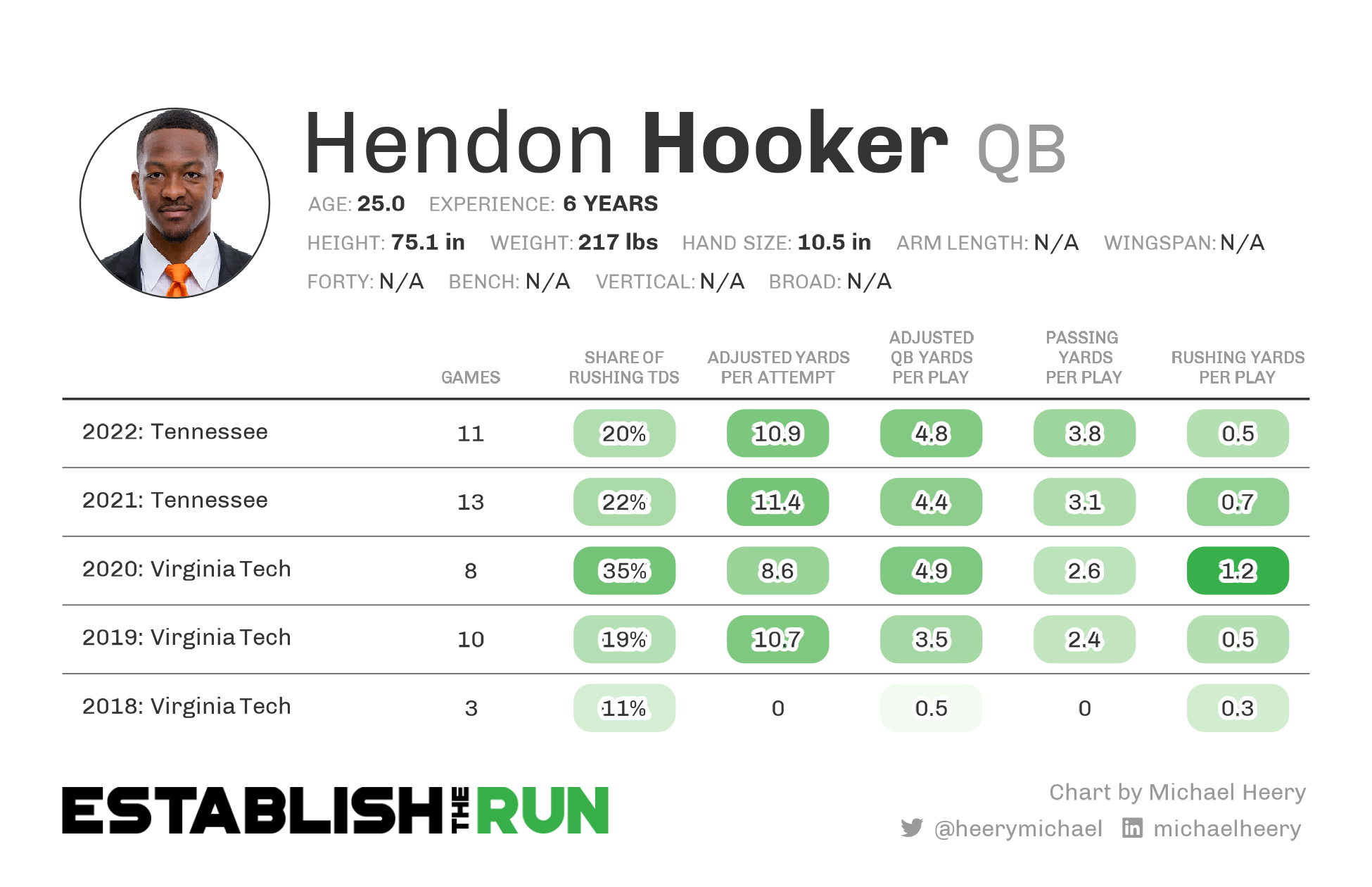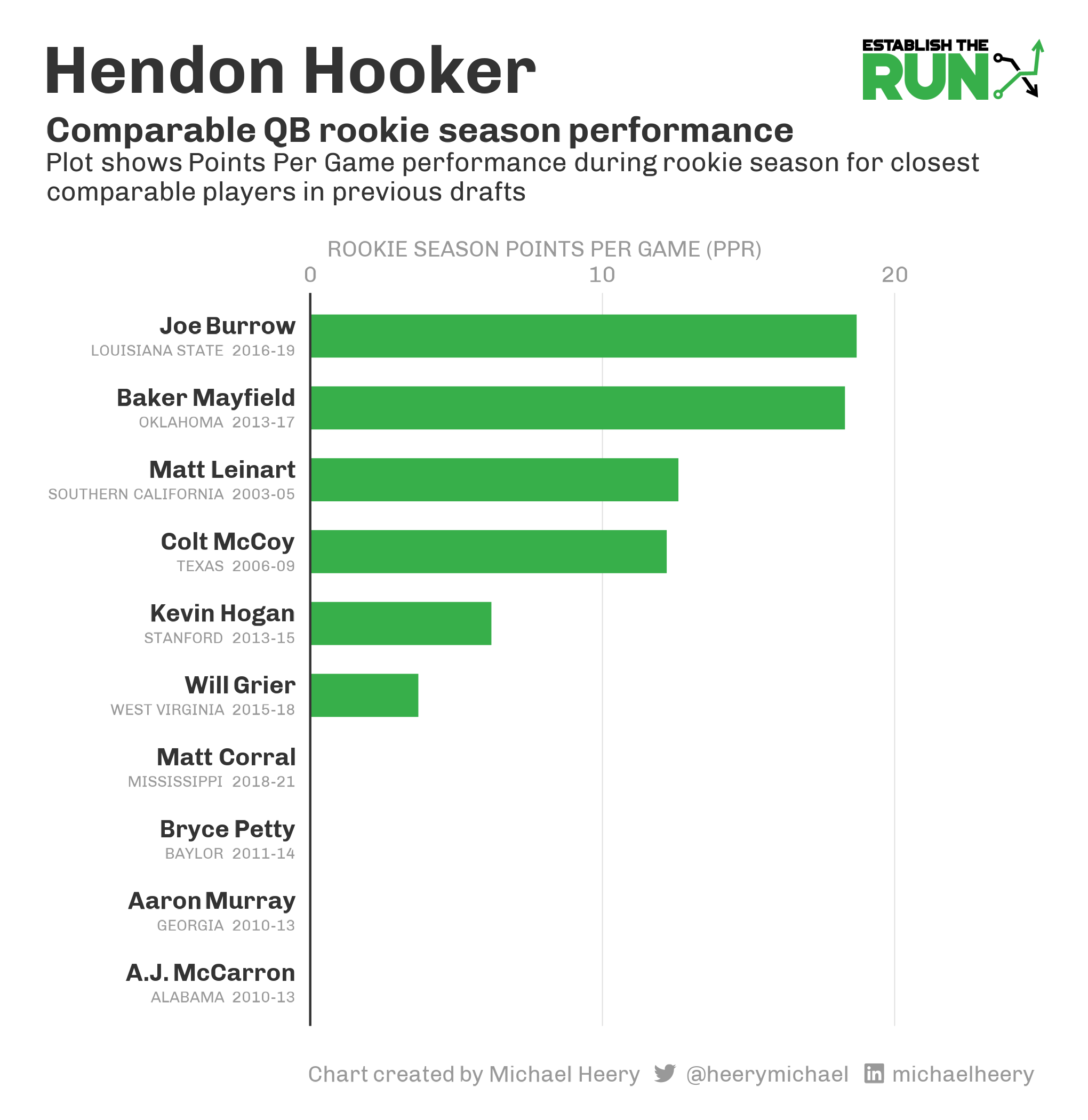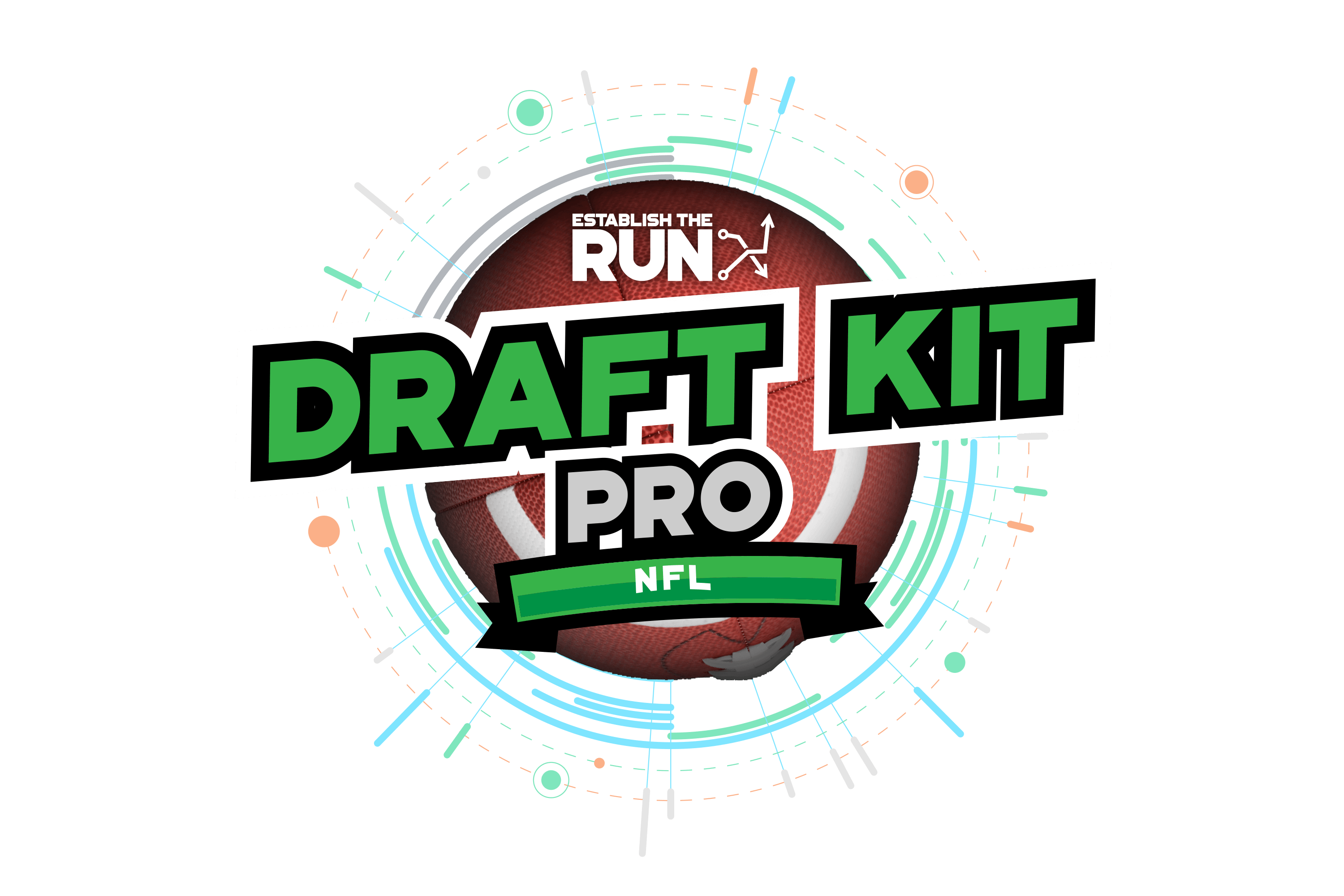Dynasty Outlook
April 21
Hendon Hooker is our QB5 for rookie drafts and checks in as QB30 in our overall dynasty ranks. He is one of the most difficult dynasty values to nail down in this class, given his advanced age and the collegiate offense he is coming from. However, there was enough production at Virginia Tech to warrant a bull case when also considering the mobility that Hooker showed at both of his stops in college. We know that QBs tend to have longer careers than players at other positions. If he ends up being a hit, that likely isn’t going to have a huge impact on his value. Our ranking right now leans more into Hooker receiving first-round draft capital, and it would be scaled back aggressively if he found himself still on the board in Round 3.
Profile Summary
Hooker is a tough evaluation coming out of Josh Heupel‘s offense, which is noted by the scouts. With that said, they also mention many positive traits that Hooker has as a QB. The injury somewhat magnifies that difficulty since we will not have any athletic testing, but his mobility was evident in the results. If he can return to pre-injury form, it seems there is still a decent chance of him becoming an NFL starter. Hooker would be the oldest first-round QB since Brandon Weeden (2012, 28 years old).
Vitals
Age (as of 12/31/22) — 25.0
Experience — 6 years
By the Numbers

Hooker is a six-year player, which gives him a rather unique path to the NFL from the start. He redshirted as a freshman at Virginia Tech, then played sparingly in Year 2 before starting 15 games total in his third and fourth seasons. Overall, he had a 9.7 AYA and 159.8 QB efficiency rating as a Hokie.
Hooker graduate transferred to Tennessee to play for Josh Heupel, who has an extremely QB-friendly offense. They do a lot of unique things by alignment that help give the QB easier reads and passing lanes. Hooker thrived in this system (though it is notable he was still very good at VT), posting an 11.1 AYA and 178.3 QB efficiency rating. He famously cut up Alabama for 385 yards and five touchdowns in a win against the Crimson Tide in 2022. Hooker was the favorite to win the Heisman Trophy until he tore his ACL late in the year.
Mobility was also a strong part of Hooker’s game in college. He had at least 350 rushing yards in each of his final four seasons, with 24 rushing scores in those years. The list of passers with at least 500 attempts, a 160.0 QB efficiency rating, and 1,000 rushing yards is impressive:
Sam Howell
Justin Fields
Jalen Hurts
Kyler Murray
Baker Mayfield
Marcus Mariota
Johnny Manziel
Tim Tebow
Alex Smith
Most of these players (7 of 9) were first-round picks. This is a good sign for Hooker’s potential draft position.
What the Scouts are Saying
Lance Zierlein notes that Hooker’s collegiate offense made some things easier:
Hooker’s age and ACL tear will be starting points for many draft conversations, but the most important question to be answered is whether he can thrive outside of the Tennessee offense. Hooker was frequently a half-field reader, which means he could lean on spacing, speed, and/or route combinations to make life easier. He’s more accurate outside the numbers than between the hashes and his deep-ball placement was much more uneven than expected. However, Hooker plays with excellent poise and footwork as a pocket passer. He will make quarterback coaches and play-callers happy with his adherence to keeping plays on schedule. He’s still showing signs of improvement and growth at the position, and his ability to hurt teams with his legs creates opportunities to help his offense outside of what he does in the pocket. His recovery from the ACL tear will require monitoring, but he has the talent to become a starter in a timing-based, spread offense.
Daniel Jeremiah describes Hooker as a quality starter:
Hooker is an ultra-productive QB with size, accuracy, and athleticism. He operates in the Vols’ unique spread attack, where they send their outside wideouts to the extreme edges of the field and force opponents to defend them in space. Hooker has outstanding field vision, makes quick decisions, and delivers the ball in a position where his receivers can easily run after the catch. He doesn’t have a powerful arm, but he can make all of the necessary throws. He throws a beautiful deep ball. He has the athleticism to extend plays and he’s very effective on designed QB runs. Unfortunately, he suffered an ACL injury late in the season that could jeopardize his rookie campaign. Also, his age (25) is a concern for some teams. Overall, I see Hooker as a quality starting QB and wouldn’t be shocked if he has the best career of any passer in this year’s class.
Dane Brugler lists a myriad of positive traits for Hooker:
Overall, Hooker must refine his internal clock and progression reads, but his instinctive athleticism, football character, and poised decision-making amid chaos are appealing traits. He projects as a developmental passer with down-the-road starting potential, as long as his knee is healthy.
Draft Projection
Hooker has an average draft position of 34.9 on Grinding the Mocks, which sources mock drafts around the interwebs. Mock Draft Database is a similar service that has Hooker 38th overall. He went 23rd in Todd McShay’s latest two-round mock draft, and he was the 37th pick in Brugler’s seven-round mock. Hooker’s draft position ranges from the mid-first to the mid-second rounds.
Comparable Players
I use Principal Component Analysis to evaluate prospects. In simplest terms, this kind of analysis looks at relevant data points to find the closest comparable players in past drafts. I prefer this to a model output — which yields only a single result — as it can display the possible range of outcomes for a prospect.
Note that the analysis itself isn’t telling us how good a player is; it is simply returning the most similar players. It is then up to us to layer in context and past results to see how good we think this player may be.

As you can imagine, there simply are not a lot of QBs with Hooker’s combination of age, experience, production, and projected draft capital. As a result, we get an extremely wide range of forecasted outcomes in the comps. The bottom six players have all failed to see serious playing time in the NFL, and they serve as a warning for what can happen if Hooker doesn’t become a Day 1 pick. He should be moved somewhat aggressively down our ranks if he slides into the third round.
Of those who did see a reasonable amount of playing time, Colt McCoy has been a solid NFL backup, and Matt Leinart completely flamed out. Baker Mayfield appears to be on that track as well. The only true success story on the list is Joe Burrow — which is the absolute best kind of hit you can find. In general, comps may not be the best way to evaluate Hooker, but it is certainly not a process that looks upon him kindly.



